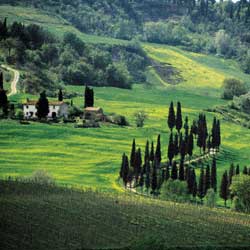|  Chianti
lies between two important cities, Firenze and Siena, and extends from
the Arno basin to that of the Ombrone; it takes in the Valdelsa to the
west, while to the east it reaches the Valdarno Superiore. Chianti
has always been a wine-producing area (there is evidence of viticultural
activity right back in Etruscan times), and it is worth visiting both
for the unmatched beauty of its natural landscape (inextricably inter-related
with the work of man) and for the many villages, castles, and farms dotted
around the area. Known throughout the world, this area is divided
into two parts, the Chianti Fiorentino and the Chianti Senese. Chianti
lies between two important cities, Firenze and Siena, and extends from
the Arno basin to that of the Ombrone; it takes in the Valdelsa to the
west, while to the east it reaches the Valdarno Superiore. Chianti
has always been a wine-producing area (there is evidence of viticultural
activity right back in Etruscan times), and it is worth visiting both
for the unmatched beauty of its natural landscape (inextricably inter-related
with the work of man) and for the many villages, castles, and farms dotted
around the area. Known throughout the world, this area is divided
into two parts, the Chianti Fiorentino and the Chianti Senese.
Running through this historic territory is the Via Chiantigiana, which
joins Firenze and Siena. Off this main route there are innumerable roads
(both asphalt and dirt roads) leading to ancient parish churches, castles,
and farms.
Starting from the north, the first important village on the Via Chiantigiana
is Impruneta, famous not only for the production of wine and olive
oil, but also and above all for its terracotta. The most famous 'cotto'
comes from here, and it was even used to cover the dome of Firenze
cathedral.
Continuing southwards you come to Strada in Chianti, which got
its name because it developed along the old Via Cassia Imperiale built
by order of Emperor Hadrian in 123 AC. Further south there is (amongst
others) the Castello di Verrazzano, birthplace of the famous navigator
Giovanni.
After crossing the river Greve at Ponte di Rimaggio, you arrive
at Greve in Chianti. This sprang up in the Middle Ages as an extension
of the Castello di Montefioralle (still within its walls), and
then developed as a market village because of its position at the crossroads
of two main routes. The Via Chiantigiana proceeds along the river Greve,
then leaves it and runs between oak trees and vineyards until it reaches
Panzano, a small village where many people take their holidays. There
is an interesting and well-preserved old castle here.
The road runs between the Chianti hills and after a few kilometers
you arrive at Volpaia, where you can find the Commenda di S. Eufrosino,
a fine example of Renaissance culture. Not far south there is Radda
in Chianti, which today is the headquarters of the Consorzio del Chianti
Gallo Nero. The history of this village, which has experienced many ups
and downs over the course of time, has been documented since 1984 by the
Centro Studi Storici Chiantigiani, which is based in the Fattoria di Vignale.
To the south-east of Radda there is the well-known wine-producing
village of Gaiole in Chianti, which saw considerable development in
past centuries as a market centre because of its position on the route
towards the Valdarno.
To the south-west of Radda is the village of Castellina, which
occupies a kind of panoramic balcony over Chianti, positioned on a high
hill at the centre of three valleys. It is one of the most important centres
of inhabitation in the Chianti, and many people take their holidays here;
its medieval structure is intact both in the centre and in the buildings
dotted around the surrounding countryside, which today are mainly holiday
homes.
A visit to the famous Castello di Brolio to the south of Gaiole
is a must; a Florentine outpost in the territory of Siena, in the past
it was the scene of conflict between the two cities. Since the first half
of the nineteenth century it has been the property of the Ricasoli family
and is one of the largest wine estates in the Chianti area.
Carrying on towards Siena, you come to Castelnuovo Berardenga,
one of the points of entry to the Chianti area for those arriving from
the direction of Rome. Besides the production of wine, this village is
also well-known for its wrought iron craft trade. This village to the
north-east of Siena is on the edge of the Chianti, whose boundaries
were fixed by law in 1929. Its main product, Chianti wine, was the work
of Barone Bettino Ricasoli who in 1800 established the proportions of
the various grape varieties from which it is made and which make it unique.
Picture by Sandro Santioli
|